A brief explanation of words used in Kate’s adventures.
Please note, some of these words have evolved and their usage changed over the years. These definitions are correct for the mid 1800’s.
adventuress; the feminine form of adventurer, and sometimes used (particularly in the late 1800s) to describe clever, beautiful, dangerous women who took advantage of wealthy powerful men for societal and financial gain
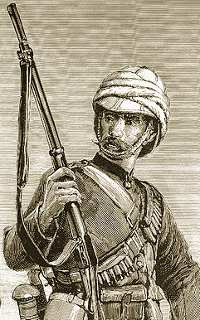
bandolier, Egypt, 1884
bandolier; (bandoleer) a shoulder belt with pouches for carrying ammunition, from the French bandouliere for a similar belt for carrying coins, in use from the 1570s, as hard cased cartridges came into use in the 1850s bandoliers were developed with specific calibre sized loops
Barbary; a term for the lands of north Africa not including Egypt, derived from barbarian, the Barbary pirates raided southern Europe and Britain from the 16th to the 19th centuries to capture white slaves for the market in North Africa and the Middle East
barker; an individual who attempts to attract patrons to entertainment events
barking iron; a firearm, usually a pistol
Baron/Baroness; hereditary, the lowest rank in the peerage, occasionally awarded for service
Baronet/Baronetess; an honour awarded to commoners, often soldiers, occasionally hereditary
barrel; a cask of variable size but often with a 31 to 36 imperial gallon capacity (141 to 164 litres)
bashibazouk; Turkish for free headed, or leaderless, irregular soldiers of the Ottoman army, noted for their lack of discipline, brutality, and ruthlessness
batman; pronounced bawman, short for bat-horse man (bat being old French for packsaddle), a soldier servant who tends to all an officer’s equipment, uniforms, and kit
batsman; a hired brute with a cudgel for a weapon, perhaps drawn from the cricket term
bazaar; a market place
bertha; a collar or trimming, worn about the shoulders and across the breast of a low cut bodice for decoration and modesty
bivouac; to camp in the wilderness
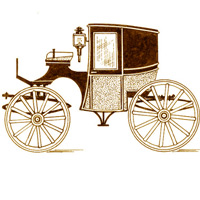
brougham
blast; gunpowder
blunderbuss; from the Dutch donderbus meaning thunder pipe, a muzzle-loading firearm with a short large calibre barrel, often flared at the opening
bodice; the body of a dress or blouse
bracers; armour covering the forearm, shortened from vambraces
breeches; riding trousers, often snug form fitting, laced, buckled or buttoned below the knee, generally made of tough material or leather, but sometimes fine fabric then reinforced with leather on the inside of the legs and bottom
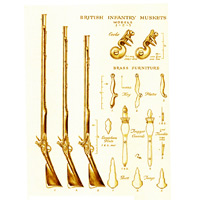
Brown Bess
brougham; a light four-wheeled coach, two doors, one bench and a front window
Brown Bess; nickname, the British Army’s Land Pattern Musket, .75 calibre flintlock, saw service from 1722 until 1838, then sold in large volumes
burnoose; a hooded cloak, often with material to swathe the face
busby; hussar headdress, a cylindrical fur cap, having a bag of coloured cloth hanging from the top and down to the side, typically to the right within British regiments
butcher’s bill; a count of soldier casualties after a battle
calèche; French term for a hood, often wool with silk, satin, or velvet lining, and decorated with tassels and ribbons
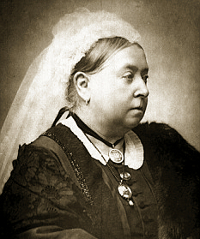
cameos, Queen Victoria wearing a few
cameo; jewellery, a relief carving, usually oval of conch shell, worn on a ribbon or pinned at the throat, they were also produced from gems and stones
camera obscura; the earliest form of projector, a simple mirror and lens
camisole; a small shirt, halter top-like undergarment
cannonade; continuous cannon fire, usually concentrated volleys
canter; a horse gait equalling ten to seventeen miles per hour (sixteen to 27 km per hour)
cartridge belt; a shoulder belt with a pouch for carrying bullets
charger; a powerful warhorse
cheroot; an inexpensive cigar with untapered open ends
chemise; an undershirt of varying lengths, a pull-over often with lace edging, not buttoned as it was worn under corsets
chiffon; a sheer fabric of silk in plain weave used for ribbons and lace
choke damp; an atmosphere so low in oxygen and high in other gases as to cause chocking, often fatal
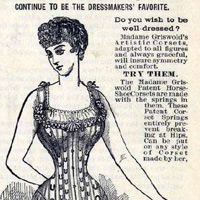
corset advert
clandestine tasking; a secret mission
clarence; an enclosed four-wheeled coach with two benches and large windows including a front pane
coming out; an age when a young lady makes her first official appearance in society, usually after completing her education and training; fifteen to eighteen, but as young as twelve
commissionaires; retired soldiers, usually veterans of many battles, retained in service as reliable security guards, founded in 1859
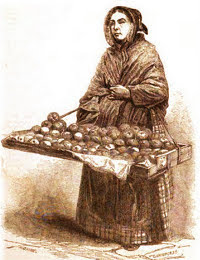
costermonger
coquelicot; French for poppy, during the 1800s it was used in fashion for bright red, generally applied to feminine clothing
corset; a formfitting undergarment enclosing the torso, often stiffened with baleen (whalebone), or similar material and capable of being tightened by lacing, by the early 1860s sprung steel was most common
costermonger; a street seller of fruit, vegetables, muffins, &c.
Count/Countess; a hereditary title of large land owners, occasionally awarded for outstanding service
crepe; fabric of silk or cotton, with a finely crinkled or ridged surface and woven so no shine is produced
daguerreotype; a photographic process invented in 1839, in which an image formed on a silver surface prepared with iodine and exposed to mercury vapour
despatch/dispatch rider; a cavalry messenger, usually a small excellent horseman on a superior mount
drawers; an undergarment, shorts, both sexes, for women crafted in two halves with an open crotch, button closures and sewn crotch seams developed through the mid to late 1800s
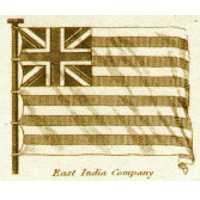
East India Co. Ensign
dray; a low strong heavy cart
drill; a tough, long lasting, twilled cotton fabric
Earl; the English equivalent of a Count
East India Company; an English joint-stock company that traded mainly in cotton, silk, indigo dye, saltpetre, tea, and opium, and ruled large areas of India exercising military power and assuming administrative functions
egad; a mild expletive, from ‘my God’
engageantes; under sleeves, often of delicate material, worn with elastic at the elbows or tacked into the bulky sleeves of a gown or jacket, removed for laundering
estafette; French for a military courier or despatch rider
Factories; a term particular to business markets in China, an agent’s office to act as factor (accountant)
farthing; one quarter of a penny
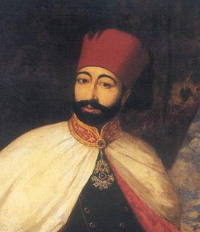
fez, Ottoman Sultan Mahmud II, in an early form of the hat, 1830
fez; a stiff felt hat in the shape of a truncated cone, produced in many colours but most commonly red, adopted as the official headdress of the Ottoman Empire in 1826
florin; two shillings, or 24 pence
fortnight; two weeks
functionals; tests, to determine if something works properly
galloon; a braid used as trim, rather like rope, often woven with silver or gold thread, used on military tunics as decoration but also designed to protect the wearer from wounds
gallop; a horse gait equalling 30 to 40 miles per hour (48 to 64 km per hour)
gentry; wealthy landowners, knights and baronets
gesso; a mixture of gypsum and glue used to prime canvas
goggles; padded strapped protective eyeglasses, a term first recorded in 1715
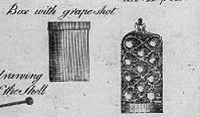
grapeshot
grapeshot; anti-personnel ammunition used in cannons providing an effect similar to a shotgun, the balls were loaded in canvas bags and resembled a cluster of grapes, also known as canister
green sickness; chlorosis, a form of anemia named for the greenish tinge of the skin, it was thought to be related to celibacy
guinea; 21 shillings, or 252 pence
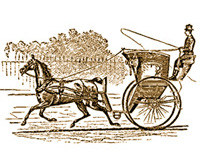
hansom
hack; a horse for hire
half a crown; two shillings and six pence, or 30 pence
hansom; a two-wheeled one horse covered carriage for two passengers with the driver mounted on an elevated seat behind
harlot; a prostitute
Hessian heel; a high strong heel originally designed for stirrups
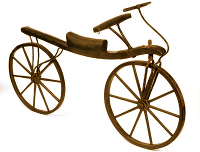
hobby/dandy horse
hobby horse; aka dandy horse, an early form of bicycle, moved by merely paddling the feet along the ground, first produced in London by D. Johnson, 1818
hogshead; a cask with a 54 to 79 imperial gallon capacity (about 245 to 360 litres)
hose; sheaths for feet and legs, the best of which were tailor made (knitted) of silk or worsted wool for the purchaser, layers of stockings could be worn over them for warmth and to protect the silk from wear
hoy; an exclamation, a shout or hail, used to attract attention
hoyden; a tomboy, an unfeminine or boisterous carefree girl
irons; pistols
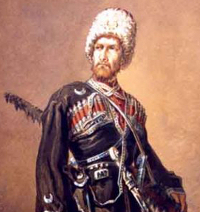
kubanka, a Caucazian soldier in the 1860s
japanned; covered with layers of varnish, polished
knacker; a person who buys up old horses for slaughter
knocker; a person employed to wake others, before alarm clocks became common hundreds of these individuals would fan out across a city in the morning usually claiming a certain district
kubanka; a cylindrical fur hat, often with a brightly coloured felt top, from which busbys evolved
landau; a four wheeled convertible social carriage (with facing seats), the soft folding top is divided into two sections, front and rear, latched at the centre, invented in the 1700s but not produced in England until the 1830s
lappet; a small flap or piece of lace, trim, &c, crafted to hang from a headdress, sleeve, hemline, &c.
lascar; a sailor from the East Indies
le bon ton; the beautiful two thousand, referring to Britain’s high society, especially during the Regency period (1811 to 1820)
league; three land miles (4.8 km), or 15840 feet, or three nautical miles (5.6 km), or 18228 feet
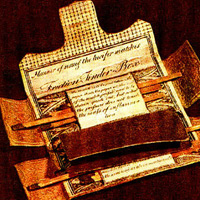
lucifers
Lord; a form of address for Earls, Counts and Viscounts
l’outrance; French, translated as “to excess” or “to the uttermost” and used in reference to a fight or duel, meaning no rules or mercy, to the death, evolved and shortened from “joust a l’outrance” or “attaque a l’outrance”
lucifer; a friction match invented around 1830
macassar oil; coconut or palm oil, with ylang-ylang oil, and schleichera trijuga, used as a hair conditioner
mantelet; a short cloak covering only to the waist
mantle; a loose sleeveless cloak or cape
mews; a term peculiar to London meaning a row of stables, originally referring to falcons and mew time (moulting)
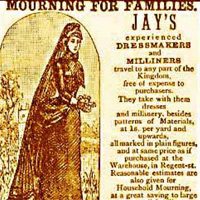
mourning dress advert
mizzling; a light rain of very fine droplets
mourning dress; lustreless black clothing, including buttons and trim, a veil for widows, and often a black armband
mulatto; a person with one black parent and one white parent
muster; to gather or parade, in military parlance, usually a morning meeting to check troop numbers and availability
nonchalante; a travelling corset, made with elastic to provide free movement, appeared around 1850
octoroon; the offspring of a quadroon and a white, a person having one-eighth black ancestry, in use by the 1840s (see quadroon)
odds zounds; a mild expletive, from God’s wounds, similar to gadzooks or odzooks, from God’s hooks
opium trade; the sale of opium from India to other countries, and opium smuggling into countries where it was illegal
ordnance; a military term for munitions
panchtar; a five stringed lute most commonly associated with Afghanistan
pantalettes; (also pantelettes, pantalets) drawers, usually a term used for children, an undergarment in the form of shorts, most commonly cotton, linen, silk, and often lacy
parley; a discussion or meeting, from the French parlez; to talk
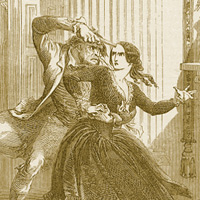
a typical penny dreadful illustration
pawky; tricky
peerage; members of the nobility ranking from dukes to barons
pelisse; a cavalryman’s small jacket that evolved into a cape (but retained the sleeves), fur trimmed with much braiding and buttons, worn on the off shoulder to act as protection from sword slashes, also referred to as a slinging jacket
pence; plural for penny
penny dreadful; a serial of sensational illustrated booklets of adventure, usually including crime and violence, which first appeared in the 1830s, also known as penny horrible, penny awful
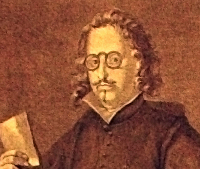
pince-nez
pepperbox; a broad term to describe a pistol with several barrels, two to eight, some designed to fire all at once, others one barrel at a time through a rotating mechanism
petticoat; a bulky skirt (trimmed, flounced, ruffled) worn under a dress to provide volume, often several worn together of varying lengths made of different fabrics from silk to flannel
pince-nez; French for pinch nose, a small pair of spectacles without arms, dating back several centuries
pinchbeck; not genuine, a cheap imitation, named after Christopher Pinchbeck, an English watchmaker, who invented an imitation gold of copper and zinc around 1700
pipe; a large cask of up to 126 imperial gallons (573 litres)
plançon
plançon; a medieval infantry weapon for smashing and thrusting, a long cudgel with a spike protruding straight from the top
pony; a small horse, less than 14.2 hands at the top of the withers (58 inches, 147cm)
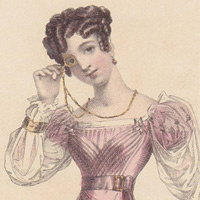
quizzing glass
porte-cochère; a French term for a carriage porch, meaning a covered driveway with an entrance door to an inn or grand manor, evolved into car port
pound; 20 shillings, or 240 pence
quadroon; from the Spanish word cuarterón, the offspring of a mulatto and a white, a person having one-fourth black ancestry (see mulatto)
quizzing glass; a sort of monocle with a handle
reticule; a small handbag
rookery; an overcrowded slum, often with buildings falling down around the inhabitants
Royal Society; a learned society for science, founded in 1660, based in London
rundlet; a small cask with a capacity of 15 imperial gallons (68 litres)
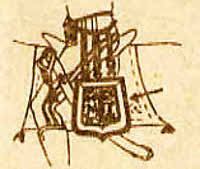
sabretache
sabretache; originally similar to a sporran and serving as a pocket, by the late 1700s it was a flat stiff leather case hung from a belt, ranged from plain to fancy, some functional others purely decorative, worn by cavalry regiments, often to carry despatches on the battlefield, contained paper and pencils, maps, ruler, &c, and served as a portable little writing surface
satchel; a bag of various sizes with a shoulder strap
scullery; where dishes were washed and stored
scullion; used as a term of abuse referring to the bottom of the servants, the scullery maid
scurf; small particles of epidermis which exfoliate from a person’s skin
shabrack/shabraque; a large cloth made to cover a cavalry saddle for parades, crafted of regimental colours, rounded front corners and pointed rear corners, regimental crest or royal cypher on the rear corners, upon the shabraque would be placed a sheepskin, bearskin, &c.
shagreen; an untanned leather with a granular surface, prepared from the hide of a horse, shark, seal, &c, and commonly used to cover the grip/handle of sabres
shako; a cylindrical hat, in military parlance, usually stiffened and with a visor, designed to withstand a sabre slash from above
shampoo; to massage, from the Hindi word champu, by the mid 1800s it was used as a wash and massage, as in shampoo your teeth, shampoo your scalp
sherryvallies; thick winter riding trousers or overalls, fastened on the outside of each leg with buttons, from the Polish word szarawary
shilling; twelve pence
Sir; a form of address for Knights and Baronets
slinging jacket; see pelisse
solar; usually a sitting room with many windows for sunshine
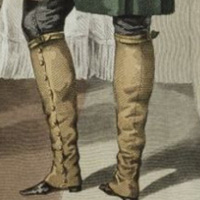
spatterdashes
sovereign; re-introduced in 1817, a gold coin equal to a guinea
spatterdashes; also spatterdashers, gaiters, leggings of canvas, sailcloth or leather, buttoned up the outside, of varying lengths from mere anklets to full leg
spencer; a short close fitting jacket, frequently trimmed with fur, worn by women and children
spread broads; play cards
steeplechase; a horse race through the country from church to church without a set path
stone; fourteen pounds (6.35 kg)
street Irish; the desperately poor Irish immigrants who filled English cities during the “Hungry 40s” (1840s) and formed much of the gangs and criminal class through the 1850s to 70s
tabouret; an artists portable kit, often including a folding stool, easel, and case of supplies
taffeta; silk, usually smooth, crisp, and lustrous, plain-woven, and with a fine crosswise rib effect
tantivy; a wild gallop, and used as a hunting cry
taskings; military term, plural for specific duties assigned to an individual that require action

tight-lacing and toothbrush
tight-lacing; the use of a corset to constrict a woman’s torso for an hourglass figure
tippet; a scarf-like garment, usually of fur or wool, covering the neck and shoulders with ends hanging down the front
toff; a member of the upper class
toffer; a prostitute with upper class clients
toothbrush; mass produced by 1840, the finest with a silver handle and badger hair bristles
topper; a top hat
tragacanth gum; a paste from Persia generally made of goat’s thorn weed
trot; a horse gait equalling eight to ten miles per hour (thirteen to sixteen km per hour)
tucker; a strip of material or lace sewn to the inside of a bodice neckline, serving as a modesty piece
turfite; any member of the horse racing community, whether a breeder, owner, trainer, gambler, &c.
valise; a small or medium sized shapeless leather case similar in style to a modern duffel bag
Viscount/Viscountess; hereditary, the rank between Count and Baron, also the eldest son or daughter of an Earl or Count, occasionally awarded for outstanding service
waistcoat; a sleeveless buttoned garment, a vest
walk; a horse gait equalling three to four miles per hour (five to six and a half km per hour)
yawning; intercourse
Yid; short for Yiddish, derogatory term for Jewish, not commonly used until the 1870’s
yobs; boys
If you encounter a word in the Adventures that isn’t familiar, or used in today’s parlance unlike what your dictionary defines, please send the editor a note and it will be added here with an explanation, and perhaps an image.
